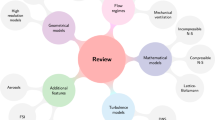Abstract
This work has started from the necessity of improving the accuracy of numerical simulations of COVID-19 transmission. Coughing is one of the most effective ways to transmit SARS-CoV-2, the strain of coronavirus that causes COVID-19. Cough is a spontaneous reflex that helps to protect the lungs and airways from unwanted irritants and pathogens and it involves droplet expulsion at speeds close to 50 miles/h. Unfortunately, it’s also one of the most efficient ways to spread diseases, especially respiratory viruses that need host cells in which to reproduce. Computational Fluid Dynamics (CFD) are a powerful way to simulate droplets expelled by mouth and nose when people are coughing and/or sneezing. As with all numerical models, the models for coughing and sneezing introduce uncertainty through the selection of scales and parameters. Considering these uncertainties is essential for the acceptance of any numerical simulation. Numerical forecasting models often use Data Assimilation (DA) methods for uncertainty quantification in the medium to long-term analysis. DA is the approximation of the true state of some physical system at a given time by combining time-distributed observations with a dynamic model in an optimal way. DA incorporates observational data into a prediction model to improve numerically forecast results. In this paper, we develop a Variational Data Assimilation model to assimilate direct observation of the physical mechanisms of droplet formation at the exit of the mouth during coughing. Specifically, we use high-speed imaging, from prior research work, which directly examines the fluid fragmentation at the exit of the mouths of healthy subjects in a sneezing condition. We show the impact of the proposed approach in terms of accuracy with respect to CFD simulations.
Access this chapter
Tax calculation will be finalised at checkout
Purchases are for personal use only
Similar content being viewed by others
References
Arcucci, R., Mottet, L., Pain, C., Guo, Y.K.: Optimal reduced space for variational data assimilation. J. Comput. Phys. 379, 51–69 (2019)
Asch, M., Bocquet, M., Nodet, M.: Data Assimilation: Methods, Algorithms, and Applications, vol. 11. SIAM, Philadelphia (2016)
Bourouiba, L., Dehandschoewercker, E., Bush, J.W.: Violent expiratory events: on coughing and sneezing. J. Fluid Mech. 745, 537–563 (2014)
Bradski, G.: The openCV library. Dr. Dobb’s J. Softw. Tools 25(1), 120–123 (2000)
Guha, A., Barron, R.M., Balachandar, R.: Numerical simulation of high-speed turbulent water jets in air. J. Hydraul. Res. 48(1), 119–124 (2010)
Gupta, J.K., Lin, C.H., Chen, Q.: Flow dynamics and characterization of a cough. Indoor Air 19(6), 517–525 (2009)
Jain, M., Prakash, R.S., Tomar, G., Ravikrishna, R.: Secondary breakup of a drop at moderate weber numbers. Proc. Roy. Soc. Math. Phys. Eng. Sci. 471(2177), 20140930 (2015)
Jayaweera, M., Perera, H., Gunawardana, B., Manatunge, J.: Transmission of covid-19 virus by droplets and aerosols: a critical review on the unresolved dichotomy. Environ. Res. 188, 109819 (2020)
Kalman, R.: A new approach to linear filtering and prediction problems. Trans. ASME J. Basic Eng. 82(1), 35–45 (1960)
Kalnay, E.: Atmospheric Modeling, Data Assimilation and Predictability. Cambridge University Press, Cambridge (2003)
Liu, D.C., Nocedal, J.: On the limited memory BFGS method for large scale optimization. Math. Program. 45(1–3), 503–528 (1989). https://doi.org/10.1007/BF01589116
Lorenc, A.: Development of an operational variational assimilation scheme. J. Meteorol. Soc. Japan 75, 339–346 (1997)
Pain, C., Umpleby, A., De Oliveira, C., Goddard, A.: Tetrahedral mesh optimisation and adaptivity for steady-state and transient finite element calculations. Comput. Methods Appl. Mech. Eng.Comput. Methods Appl. Mech. Eng. 190(29), 3771–3796 (2001)
Pavlidis, D., Gomes, J.L.M.A., Xie, Z., Percival, J.R., Pain, C.C., Matar, O.K.: Compressive advection and multi-component methods for interface-capturing. Int. J. Numer. Meth. Fluids 80(4), 256–282 (2016). https://doi.org/10.1002/fld
Scharfman, B.E., Techet, A.H., Bush, J.W.M., Bourouiba, L.: Visualization of sneeze ejecta: steps of fluid fragmentation leading to respiratory droplets. Exp. Fluids 57(2), 1–9 (2015). https://doi.org/10.1007/s00348-015-2078-4
Sun, W., Ji, J.: Transport of droplets expelled by coughing in ventilated rooms. Indoor Built Environ. 16(6), 493–504 (2007)
Wei, J., Li, Y.: Enhanced spread of expiratory droplets by turbulence in a cough jet. Build. Environ. 93, 86–96 (2015)
Wikle, C.K., Berliner, L.M.: A bayesian tutorial for data assimilation. Physica D 230(1–2), 1–16 (2007)
Zhu, C., Byrd, R.H., Lu, P., Nocedal, J.: Algorithm 778: L-BFGS-B: fortran subroutines for large-scale bound-constrained optimization. ACM Trans. Math. Softw. (TOMS) 23(4), 550–560 (1997)
Zhu, S., Kato, S., Yang, J.H.: Study on transport characteristics of saliva droplets produced by coughing in a calm indoor environment. Build. Environ. 41(12), 1691–1702 (2006)
Acknowledgements
This work is supported by the EP/V036777/1 Risk EvaLuatIon fAst iNtelligent Tool (RELIANT) for COVID19 and the EP/T000414/1 PREdictive Modelling with QuantIfication of UncERtainty for MultiphasE Systems (PREMIERE).
Author information
Authors and Affiliations
Corresponding author
Editor information
Editors and Affiliations
Rights and permissions
Copyright information
© 2022 Springer Nature Switzerland AG
About this paper
Cite this paper
Arcucci, R. et al. (2022). Merging Real Images with Physics Simulations via Data Assimilation. In: Chaves, R., et al. Euro-Par 2021: Parallel Processing Workshops. Euro-Par 2021. Lecture Notes in Computer Science, vol 13098. Springer, Cham. https://doi.org/10.1007/978-3-031-06156-1_21
Download citation
DOI: https://doi.org/10.1007/978-3-031-06156-1_21
Published:
Publisher Name: Springer, Cham
Print ISBN: 978-3-031-06155-4
Online ISBN: 978-3-031-06156-1
eBook Packages: Computer ScienceComputer Science (R0)




